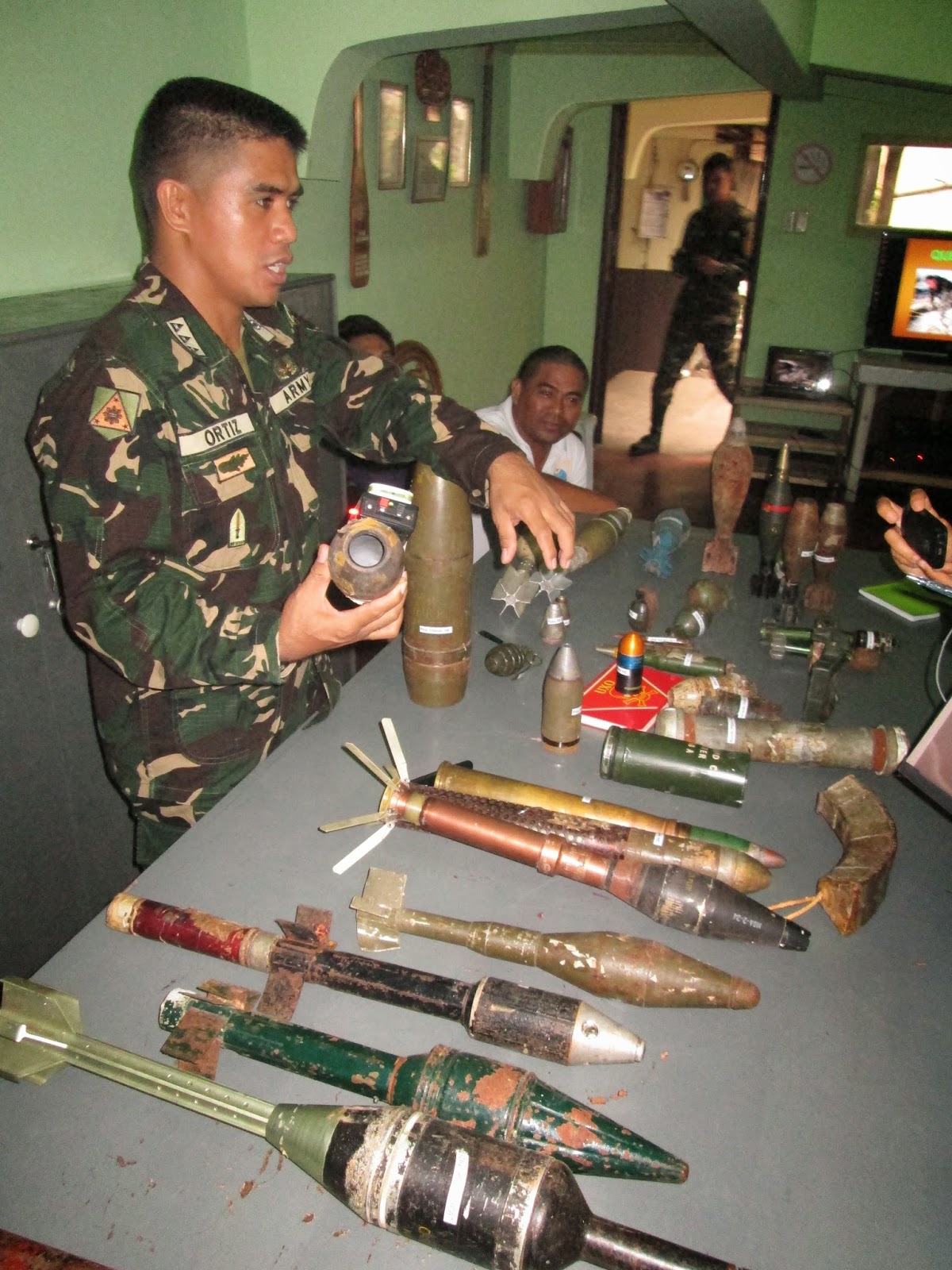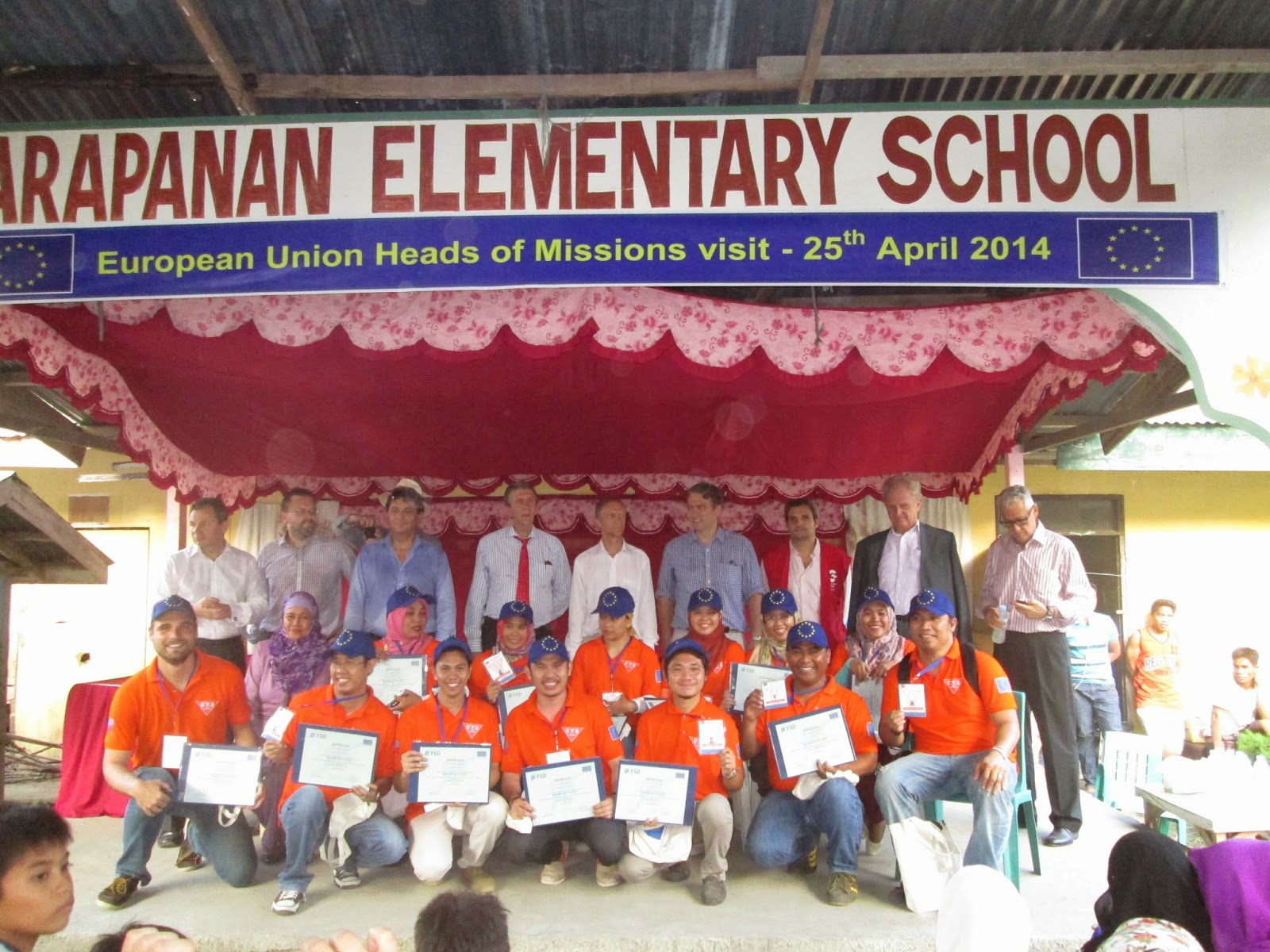The promotion of international security and the fight against political violence and its consequences are issues not limited to high politics but often have their base on the grass root level. For example, countless NGOs and volunteers work in areas affected by armed conflict, offering help and support to the most vulnerable - the civilian population. Their work is often very difficult and not seldom dangerous. In this entry I want to share my recent experiences of witnessing and taking part in the important work of NGOs on the grass root level.
 |
| FSD staff and trainees after an MRE session. Source: FSD |
Thanks to my organization’s (
South-South Network for Non-State Armed Group Engagement, SSN) close ties with the
Philippine Campaign to Ban Landmines (PCBL) I got the chance to become sort of their “guest intern”, fly to Cotabato City in Western Mindanao and take part in a one week long train-the-trainer workshop hosted by the
Swiss Foundation for Mine-Action (FSD). After the workshop I also had some time for research regarding my master thesis and field of particular interest, the situation of small arms and light weapons (SALW) diffusion and trade in the region, which will certainly be a topic for a future blog-post.
Before actually going to Cotabato City and Maguindanao, I was thoroughly warned by many of my friends in Manila about the dangers and the security situation in Mindanao, especially in the southern and western parts of the island. Indeed, there have been incidences and kidnapping is still a considerable threat especially to foreigners, but on the other hand there haven’t been any recent reports and the signing of the
Comprehensive Agreement on the Bangsamoro (CAB) between the leadership of the
Moro Islamic Liberation Front (MILF) and the Government of the Republic of the Philippines gave me some additional hope that things would go well, so I informed my embassy and booked my ticket.
One short week later I found myself in a long line of people waiting to board flight EJ 887 to Cotabato City. As expected, I stood out in the crowd, as I was the sole foreigner, a fact that didn’t remain unnoticed by the lady in front of me. After we had a short and friendly chat she lowered her voice, leaned forward and asked me with a troubled look on her face: “But you are informed, aren’t you?” “Informed of what?” I wanted to ask, but of course I knew what she meant. The fact that she didn’t even see the need to explain what I should be informed of, that the security situation was so obviously the major issue for a foreigner when going to Cotabato City did indeed not help me much in suppressing my doubts, but here I was, boarding the plane anyways.
As it turned out, all the warnings were quite exaggerated, the situation is really not as bad as many people, especially those in Manila, believe it is. Of course one has to be careful and for example not walk around alone at night, but this is advisable not only for Western Mindanao. For the first week I stayed at the dormitory of the center where the workshop took place, an unguarded compound with an easy to climb gate (I climbed it twice myself because I missed the dorm’s curfew), but everything was perfectly fine.
 |
| Our MRE train-the-trainer workshop in Cotabato City. Source: FSD |
The workshop itself started the day after my arrival and was held by the FSD staff. We, the trainees, twelve of them from the region and me, were about to become Mine Risk Education (MRE) Facilitators. Now if you know a thing or two about armed violence in the Philippines you might wonder why the workshop was about the risk of landmines as there are only few cases in the Philippines in which these were used. Currently, only the
New People’s Army (NPA) employs mines, but there has been a
recent incident in which the
Bangsamoro Islamic Freedom Fighters (BIFF), a breakaway group of the MILF, made use of a roadside bomb as well. To be precise, when we use the term landmine, we usually talk about victim-activated anti-personnel mines (APMs), which are banned under the
1997 Ottawa Treaty. This means that landmines that kill or injure indiscriminately anybody who steps on them / trips the tripwire etc. are banned, whereas command-detonated APMs like the so-called
Claymore mines (a U.S.-designed (M18A1) directional APM which can be either command or victim-activated and even both at the same time because of it’s two fuses) do not fall under the ban of the 1997 Ottawa Treaty. This is mainly because command-detonated mines are presumably discriminate as they are (ideally) detonated only against legitimate military targets. Naturally, this requires a person observing and detonating the landmine manually, usually electronically, when a military target approaches. Command-detonated mines are also more likely to be removed in case they were not detonated, while victim-activated landmines usually stay in the ground until someone “activates” them. As you can imagine, the employment of command-detonated APMs is a tactic with little use for the Armed Forces of the Philippines (AFP), but a quite powerful method of guerilla warfare.
 |
| Different types of (defused) UXOs and explosives. Source: Markus Schindler |
“But if landmines are not a big issue in the Philippines, what was the workshop all about?” you might wonder. Well, landmines are not the only explosive remnants of war (ERW) that still pose a threat to the civilian population. MRE in the Philippines, therefore, focuses on unexploded ordnance (UXO), that means projectiles like shells, mortar bombs, but also rockets, various types of grenades, aircraft bombs and even improvised explosive devices (IEDs) that were fired but that did not explode. There might be a variety of reasons why the UXO did not detonate, but this does not make much of a difference for the people who discover them, as of course only experts can deal with such dangerous explosives.
The purpose of MRE in the Philippines is to reduce the risk of injury or death from UXOs by raising awareness and promoting behavioral change. By training this batch of community workers from various local NGOs, the FSD created a new group of MRE Facilitators. These volunteers are now visiting communities that were affected by fighting to inform the locals and especially the children about the right behavior when discovering a UXO. There are four important steps that MRE sessions have to focus on in order to have a lasting impact on the community. The participants of an MRE session have to be able to (1) recognize the UXOs that are relevant in their region, (2) know in which areas UXOs can be found (which is basically everywhere), (3) learn what they should not do when discovering a UXO (there are numerous cases in which people were harmed or killed because they were unaware or underestimated the danger of UXOs) and finally (4) know about the right behavior when discovering a UXO.
 |
| Source: Markus Schindler |
The workshop was really interesting, sometimes quite intense but in the end very rewarding. We were taught a lot about the impact of UXOs, may it be physical, psychological, socio-economic or even humanitarian, and we acquired skills in recognizing UXOs and even visited an army camp in Cotabato City to take a look at some of the explosives that pose a threat to the people in affected areas. We also learned about methods of teaching communities and children of different ages, preparing and planning MRE sessions and many more things that we would need in the coming days. The second part of the training was reserved for practical exercises. So we practiced. A lot. But well, we really had to, because when the exercises were done, we went to a community, split into four groups and actually held MRE sessions for the locals. An amazing experience, trust me, but this was only the beginning. We all gained much confidence in our MRE skills from it, so after a nice lunch-break at the impressive grand mosque of Cotabato we went into a small village next to the riverbank of the Rio Grande de Mindanao and started with house-to-house sessions. It didn’t take us long to realize that quite many people in the village had already encountered UXOs and, therefore, were at risk, so we decided to gather all the villagers and have a so-called emergency MRE session.
 |
| The Grand Mosque of Cotabato City. Source: Markus Schindler |
As these experiences were already very exciting, the real hit was just about to happen. The next morning we came together to make our way to Camp Darapanan, the headquarters of the Moro Islamic Liberation Front (MILF), where we were already expected. The MILF-combatants were surprisingly friendly and waved us through their numerous checkpoints without asking questions or the appraising look one usually gets from the immigration officials at internationals airport, so we went straight to the camp’s school. Today we would hold MRE sessions for the many children that lived within Camp Darapanan, and, to put the cherry on the cake, a delegation of ambassadors from EU-countries (among them the German Ambassador to the Philippines, Thomas Ossowski) would watch our presentations and hand over our certificates.
 |
| The delegation of European ambassadors and diplomats presented certificates to the MRE trainees. Source: Markus Schindler |
 |
| I also had the honor to shake hands with Thomas Ossowski, the German Ambassador to the Philippines. Source: German Embassy Manila |
 |
| A friend of mine and I with a group of MILF combatants. Source: Markus Schindler |
Needless to say, we had a lot of fun and the children at the camp enjoyed the MRE sessions as well as we were vigorously drilled by our Sri Lankan trainer Harshi to deliver our best performance. When time went by and we almost reached the end of our sessions, the ambassadors hadn’t arrived yet. But of course, they wanted to watch our MRE session, and you don’t want to disappoint ambassadors, so we stretched the thing. A lot. Time went by very slowly and we had to improvise another hour or more, but when the delegation finally arrived everything happened really fast. I was surprised to see that a group of armed policemen convoyed the ambassadors to the camp but the MILF-combatants did not seem to worry about them, instead they talked to each other as if, well, they wouldn’t be the mortal enemies I always thought they’d be.
 |
| A group of MILF combatants at Camp Darapanan who kindly joined me for a picture. Source: Markus Schindler |
After the week of training was over, the very motivated new team of MRE volunteers met up to plan their first MRE sessions and is very diligent ever after. If you want to check out their recent activities or express your support for their effort, you can find the
Kutawato MRE Team on facebook.
The work that NGOs like the FSD is doing is not gaining much media attention, but their impact on the lives of people is enormous. I spend quite some time researching the negative consequences that arise from armed conflict for an affected region, and they are devastating. UXOs are certainly not the only problem, but their effects are some of the most direct to civilians and children in particular. I am very grateful that I was given the chance to experience and take part in these incredibly relevant activities. I hope the FSD and the growing number of MRE volunteer groups in Mindanao will succeed in increasing the safety of people who have to live in areas affected by armed violence.
